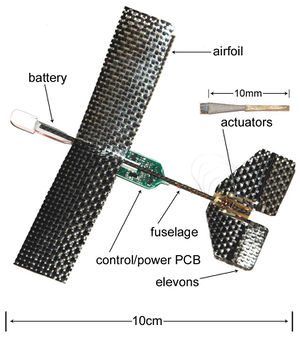Difference between revisions of "Media"
Jump to navigation
Jump to search
HectoPascal (talk | contribs) |
|||
| Line 2: | Line 2: | ||
|-valign="top" | |-valign="top" | ||
| style="width:50%"| | | style="width:50%"| | ||
== News | == Paparazzi in the News == | ||
* [http://www.elektor-electronics.co.uk/Default.aspx?tabid=27&art=53265&PN=On Elector Electronics: "Flying Robots"] - Feb 2007 | * [http://www.elektor-electronics.co.uk/Default.aspx?tabid=27&art=53265&PN=On Elector Electronics: "Flying Robots"] - Feb 2007 | ||
*:<small>As processors become ever more powerful we are witnessing the rise of more ’intelligent’ systems. We now look to sophisticated robots to assist or even replace us in difficult or hazardous environments. This is particularly true of military hardware where we have seen on our TV screens the use of unmanned aircraft and vehicles in some recent conflicts. The basic idea however is not so new; we take a look into the world of ‘drones’…</small> | *:<small>As processors become ever more powerful we are witnessing the rise of more ’intelligent’ systems. We now look to sophisticated robots to assist or even replace us in difficult or hazardous environments. This is particularly true of military hardware where we have seen on our TV screens the use of unmanned aircraft and vehicles in some recent conflicts. The basic idea however is not so new; we take a look into the world of ‘drones’…</small> | ||
| Line 24: | Line 24: | ||
* [http://www.flightglobal.com/Articles/2005/10/25/202326/DOWN+SIZING.html "Flight International: Down Sizing"] - September 26, 2005 <small> | * [http://www.flightglobal.com/Articles/2005/10/25/202326/DOWN+SIZING.html "Flight International: Down Sizing"] - September 26, 2005 <small> | ||
*:As the first generation of micro-scale UAVs, exemplified by the remote-control Wasp, reaches the hands of military users, the US Army’s MAV competition in Garmisch-Partenkirchen provided a glimpse of the future. The winning University of Arizona team’s fixed-wing MAV transmitted video while flying autonomously via GPS waypoints using an open-source flight-control software package, called Paparazzi, originally developed by France’s national aviation school Enac.</small> | *:As the first generation of micro-scale UAVs, exemplified by the remote-control Wasp, reaches the hands of military users, the US Army’s MAV competition in Garmisch-Partenkirchen provided a glimpse of the future. The winning University of Arizona team’s fixed-wing MAV transmitted video while flying autonomously via GPS waypoints using an open-source flight-control software package, called Paparazzi, originally developed by France’s national aviation school Enac.</small> | ||
* [http://www.flightglobal.com/blogs/flight-international/2005/09/from-fallujah-to-garmischparte.html "Flight International Blog: From Fallujah to Garmisch-Partenkirchen"] - September, 2005 <small> | |||
*:Robots are often used in the media to instil fear with Frankenstein like stories of the scientist and corporation having gone to far with a humanoid machine destroying all before it. But on today's battlefield, and for this US Army sponsored event, and for the war of tomorrow the robots will, apparently, look more like model planes.</small> | |||
| | | | ||
| Line 71: | Line 75: | ||
|- | |- | ||
|} | |} | ||
== Other Sites of Interest == | |||
[[Image:2g Autonomous Glider.jpg|thumb|300px|Complete autonomous glider weighs only 2 grams including LiPo battery, I2C optic flow sensor for optical obstacle avoidance, stereo microphones for locating the source of audio signals, 200V power supply, and piezoelectric actuators.]] | |||
* [http://robotics.eecs.berkeley.edu/~ronf/PAPERS/iecon05.pdf "Design, Fabrication and Initial Results of a 2g Autonomous Glider"]<br><small>(900K, PDF) - July 2007 | |||
*:Utilizing the core technologies of emerging microrobotic structures, the rapid design and prototyping of a passive micro air vehicle with the final goal of locating an audio source while avoiding hazardous obstacles is presented. The airfoil and control surfaces are optimized empirically to maximize lift and maneuverability while minimizing drag. Bimorph piezoelectric bending cantilevers actuate the control surfaces. Since such actuators require high voltages, an efficient boost circuit is presented along with appropriate high voltage electronics. To locate audio sources, a pair of acoustic sensors is designed and prototyped using a phase detection algorithm while a custom optic flow sensor is developed to avoid obstacles and give estimates of object distances and velocities. Finally, each subsystem is demonstrated and the complete glider is integrated to demonstrate initial open loop control performance.</small> | |||
Revision as of 13:19, 17 July 2007
Paparazzi in the News
|
Design Reports
|
Other Sites of Interest
- "Design, Fabrication and Initial Results of a 2g Autonomous Glider"
(900K, PDF) - July 2007- Utilizing the core technologies of emerging microrobotic structures, the rapid design and prototyping of a passive micro air vehicle with the final goal of locating an audio source while avoiding hazardous obstacles is presented. The airfoil and control surfaces are optimized empirically to maximize lift and maneuverability while minimizing drag. Bimorph piezoelectric bending cantilevers actuate the control surfaces. Since such actuators require high voltages, an efficient boost circuit is presented along with appropriate high voltage electronics. To locate audio sources, a pair of acoustic sensors is designed and prototyped using a phase detection algorithm while a custom optic flow sensor is developed to avoid obstacles and give estimates of object distances and velocities. Finally, each subsystem is demonstrated and the complete glider is integrated to demonstrate initial open loop control performance.
